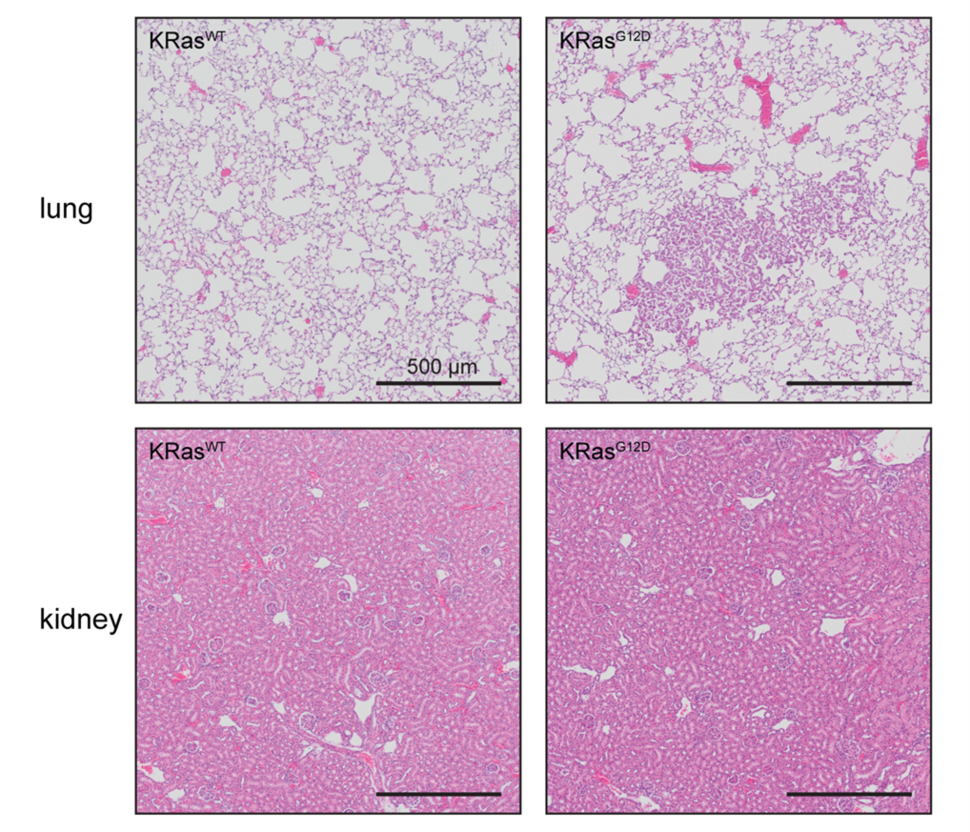Oncogene turned bystander - How molecular context shapes KRas oncogenicity
, by Olesja Popow and Kevin Haigis
Olesja Popow is a Postdoctoral Research Fellow in the lab of Kevin Haigis at the Dana-Farber Cancer Institute and is co-advised by Steven Gygi at Harvard Medical School. Her research is focused on defining and understanding the tissue-specific oncogenic activity of KRas. For this she employs a combination of proteomics, molecular biology, and mouse models. Her project is part of the SPECIFICANCER Cancer Grand Challenge which is funded by Cancer Research UK and the Mark Foundation for Cancer Research.
Kevin Haigis is an Associate Professor of Medicine at Harvard Medical School and Chief Scientific Officer at the Dana-Farber Cancer Institute. During his graduate training at the University of Wisconsin-Madison, Dr. Haigis studied the somatic genetics of intestinal tumor initiation under the guidance of Dr. William Dove. In his post-doctoral work, Dr. Haigis studied the oncogenic properties of the RAS GTPases in the laboratory of Dr. Tyler Jacks in the Massachusetts Institute of Technology Center for Cancer Research (now the David H. Koch Institute for Integrative Cancer Research).
Among all known proto-oncogenes - genes that when activated through mutations or amplifications can transform normal cells into tumor cells - KRAS is one of the most frequently mutated ones in human cancers1,2. This aligns well with our ever-growing knowledge about its central role as a driver of pro-tumorigenic cell signaling pathways3.
Nevertheless, data from both human and mouse suggest that KRas is, in fact, not a ‘universal’ oncogene and that the ability of mutant KRas to drive tumor initiation and/or progression is limited to a subset of tissues. Indeed, every study that applied mouse models to drive oncogenic KRas expression at endogenous levels across multiple tissues in the adult animal observed remarkable tissue-specific responses; despite considerable variation in the models used, the lung, digestive tract, hematopoietic system, and squamous mucosa were commonly found to be permissive to the oncogenic effects of mutant KRas. In contrast, none of the prior studies detected histological changes in tissues such as the liver, kidney, muscle, or brain4–9. We were also able to reproduce this result ourselves (see Figure 1).
Even though it has been recognized for more than 20 years, the tissue-specific oncogenic activity of KRas has largely remained unexplored. The KRas tissue permissivity pattern observed in mice largely mirrors the cancer type-specific KRAS mutation frequency seen in patients, indicating the applicability of mouse models for the study of this phenomenon2. Notably, KRas is ubiquitously expressed and its protein abundance does not correlate with the permissivity of a given tissue10,11. Nevertheless, existing studies on Ras function in permissive tissues as well as insights into basic Ras biology hint at potential underlying mechanisms.
Simplistically speaking, Ras activation requires its association with a membrane and a guanine nucleotide exchange-factor (GEF), which promotes the conversion of the inactive GDP-bound to the active GTP-bound form. GTP-bound Ras can subsequently interact with and activate effector proteins, triggering signaling through downstream pathways. Signal termination occurs through the action of GTPase activating proteins (GAPs), which convert Ras back into its inactive GDP-bound state3. Not surprisingly, a closer examination reveals an exceedingly complex picture.
The interaction of KRas with membranes is mainly governed by its C-terminus and the post-translational modifications (PTMs) located within it. KRas nanoclusters at the plasma membrane assemble a distinct combination of lipids, which in turn determine the effectors that can be recruited and activated. Membrane compositions that are unfavorable for nanocluster formation can abrogate KRas signaling12. Likewise, changes in KRas C-terminal PTMs affect nanocluster lipid composition and in turn downstream signaling output13. It is conceivable that the tissue-specific lipid profile and expression pattern of Ras-modifying enzymes could substantially influence KRas nanocluster formation and effector activation14,15.
The plasma membrane (PM) is the major site of Ras activation, but Ras-mediated signaling can also occur from endomembranes, most notably the Golgi, with marked differences in kinetics and signal outputs16–18. These insights stem mainly from experiments with N- and HRas, which share a high degree of sequence homology with KRas outside of their hypervariable region located in the C-terminus. Notwithstanding, NRas, HRas, and the KRas splice isoform KRas4A utilize the same post-translational processing route, including C-terminal palmitoylation in the Golgi16. It is thus plausible that KRas4A-mediated signaling takes place at the Golgi in addition to the PM. RasGEFs, effector scaffolds, and other coactivators with restricted subcellular localizations are thought to drive the distinct dynamics and outputs between PM and endomembrane-localized Ras signaling18. If these proteins control the balance between KRas signaling from different subcellular compartments, variety in their expression levels could have profound effects on the outcomes of KRas activation between tissues.
Compartmentalization also occurs further downstream of Ras-activated signaling pathways. This is probably best understood in the context of the kinases MEK1/2 and ERK1/2, which are sequentially activated downstream of RAF kinases. Binding of ERK (alone or in complex with MEK) by subcellular compartment-specific scaffolds controls its ability to translocate to the nucleus and can thus shift ERK substrate specificity from nuclear to cytoplasmic substrates16. Tissue-specific differences in the expression profile of these scaffolding proteins could therefore bias kinase activity towards a distinct set of substrates, thus shaping a tissue’s response to ERK activation by KRas. In support of this hypothesis, Parikh et al. observed differential nuclear localization of active phosphorylated ERK between tissues in mice expressing the oncogenic KRasG12D mutant9.
KRas can interact with and signal through a range of effectors, many of which remain understudied and may only play significant roles under certain conditions. Similarly, KRas can be activated and inactivated by numerous GEFs and GAPs, but how they contribute to differential KRas signaling is not known.
Despite a lack in detailed understanding, it is clear that a multitude of Ras pathway components have the potential to influence whether, where, and for how long activated KRas signals in a cell. The presence or absence of downstream elements can further shape signaling output. We thus hypothesize that it is the balance between the collective expression profiles of this underlying network that shape the divergent outcomes of KRas activation across contexts, for example in different tissues. Indeed, the signaling changes induced by oncogenic KRas mutants, as measured by phospho-proteomics, differ significantly between the colon and pancreas19,20. In extreme cases, the pre-existing network may not support oncogenic KRas signaling, and this could account for the apparent lack of response in tissues that are non-permissive to the effects of mutant KRas (see also 21).
This hypothesis further implies that changes to the underlying network will affect KRas permissivity and this could cause shifts in tissue tropism during development or inflammation. In theory, a variety of network states could block or allow oncogenic KRas signaling. This consequently raises the questions whether all non-permissive tissues – or, in fact, also permissive ones - are created equal. That is, do the same nodes within the network define permissiveness across all tissues. A single factor is unlikely to be the sole determinant, as it would represent an ideal target for co-mutations and would be expected to be selected for in patient tumors. In fact, germline inactivation of p53 – the most commonly mutated tumor suppressor in human cancers – in a mouse expressing a latent KrasG12D allele primarily increased tumor malignancy but did not substantially alter the range of tissues in which lesions developed. An exception were tumors originating from blood vessels (haemangiosarcomas) and connective tissue (fibrosarcomas), which were only observed in p53/Kras double mutant mice4.
Some mutations, alone or in combination with overexpression, can escalate KRas activity beyond an optimal point supportive of proliferation, instead resulting in cell senescence and apoptosis22,23. This by Li et al. termed ‘sweet spot’ likely varies between tissues and concordantly, different cancer types select for distinct KRAS (co-)mutations23,24. Yet, a range of possible optimal degrees of KRas activity and expression levels was sampled by Le Roux et al. but failed to detect any histological changes in the majority of tissues25.
Given the frequency of, and the difficulties associated with, targeting KRAS mutations in human cancers, there is an urgent need for new therapeutic approaches. Although it initially may appear counterintuitive, we argue that insights gained from studying the effects of oncogenic KRas expression in non-permissive tissues will be highly valuable for achieving this goal. Understanding the principles underlying oncogenic KRas permissivity will ultimately allow us to harness into therapeutic avenues the strategies by which some tissues can evidently block the detrimental effects of mutant KRas.

